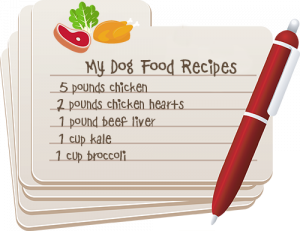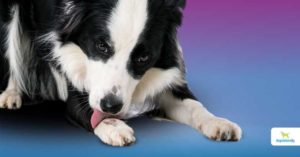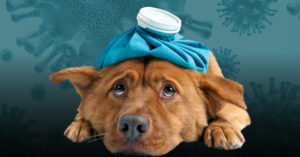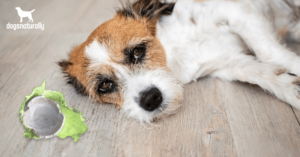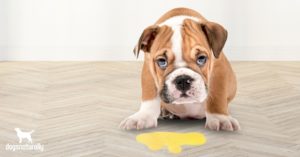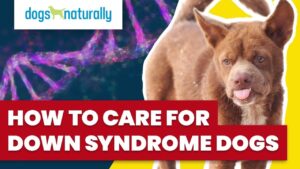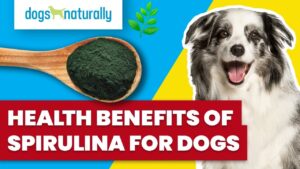Raw meaty bones are a staple of raw-fed dogs. But you still might be still hesitant about giving bones … and your concerns are justified. Even the most well-mannered, gentle chewer can accidentally break a tooth … one of the biggest fears of raw-feeding dog owners.
But you might not even notice a slab fracture. Dogs are masters at masking pain. It’s a holdover from their wild ancestors and a form of self-defense. The whine from an injured animal would draw predators so they suffered in silence. Today that same approach can lead to unnecessary infection and pain in a vital and sensitive area … your dog’s mouth.
That’s why you need to do a regular exam of your dog’s mouth and teeth. Here’s what to look for and what you need to know if your dog has a slab fracture.
What Is A Slab Fracture?
Slab fractures are the most common dental fractures in dogs. When a dog bites down on a hard object it chips off a “slab” of the tooth. It might expose the sensitive pulp cavity that is the dog’s root canal. That leads to pain and infection.
It often happens to the 4th upper premolar which is the large upper tooth near the back of your dog’s mouth. But it can happen to any tooth. And usually it’s a vital tooth needed for ripping, tearing and gnawing.
Anatomy Of A Dog’s Tooth
Your dog has 42 teeth. His teeth consist of enamel, the thin, hard outer layer. Next is the dentin, a porous material filled with nerves. Soft pulp fills the inner cavity of each tooth, known as the pulpal chamber or root canal.
The periodontium supports each tooth. The cementum lines the root of the tooth below the gum line; the periodontal ligament attaches the tooth to the alveolar bone; and the gingival tissue, or gum, surrounds the roots. Think of your dog’s tooth as being like an iceberg. About twice as much tooth area is below the gum line as above it.
When your dog chips the enamel, it exposes the dentin. That causes the tooth to be sensitive to heat, cold and pressure. It’s worse if it exposes the pulp (nerve). The tooth can become infected and that bacteria can pass through the root into the jaw. Now within the root canal, the immune system has a difficult time reaching the bacteria. This can lead to constant pain whenever the dog chews. And that’s how infection passes to other parts of the body.
Can Dogs Live With A Slab Fracture?
Chewing on anything hard, chomping down at the wrong angle or having weak bones and teeth can lead to a slab fracture. And many dogs break teeth and manage quite well.
But in some cases, the problem is that a broken tooth can become non-vital (or dead) and infected.
If your dog has a small, superficial fracture, it might not become an issue. But a large chip, crack or break near the gum line can be painful. Even if you don’t notice any bleeding or swelling, there can be a damaged nerve. And even when in this type of pain, many dogs will continue to eat as normal.
But a broken tooth can lead to infection and then the bacteria spreads through the root canal to the blood supply. It has the potential to create infection throughout your dog’s body and organs.
Here are some things to watch for that might indicate your dog could have this problem.
RELATED: The danger of dental disease in dogs …
Signs Of A Slab Fracture In Dogs
Any of these signs indicate your dog could be experiencing pain from a slab fracture.
- Unusual drooling
- Bad breath
- Loss of appetite
- Dropping food while chewing
- Grinding teeth
- Pawing at the mouth
- Turning away bones or hard treats
- Swelling around the snout
- Nasal discharge or sneezing
- Chewing on one side of the mouth
- Avoiding having his head touched
Any chip should be looked at by a veterinary dental specialist. It could expose the sensitive dentin which can be repaired without much difficulty. But if there’s an exposed root canal, it means there is definitely pain and it will lead to infection.
If your dog shows one or more of these signs he could be dealing with something serious. But before it gets to that stage, here are some things you can do regularly.
RELATED: How to care for your dog’s teeth naturally …
When To Seek Professional Dental Care
Just like you or your kids, your dog’s teeth need care. And they need the expertise of a professional who understands the dental issues of dogs.
Start by doing your own oral exams of your dog’s mouth. Check the color of your dog’s gums and look for chipped teeth on a regular basis. And if you notice swelling, red gums or a broken tooth, contact a veterinary dental professional. Most regular vets don’t have sufficient training or experience in dentistry.
Here are things you can do to prevent slab fractures and other dental issues in your dog.
9 Natural Ways To Prevent Slab Fractures In Dogs
Being proactive is the best defense against slab fractures.
Feed A Healthy Diet
The best diet for your dog is a whole food, raw meat diet. This is a diet filled with vitamins and minerals derived from food, not a lab. Natural nutrients are better for your dog and his bone health. His diet should include raw, meaty bones. Then he’ll have the benefit of ripping and tearing his food and that’s important for good dental health.
Add Antioxidants
Antioxidants include vitamins C and E, and co-enzyme Q10. They strengthen cell membranes and prevent inflammation. They also promote healing of gingivitis and inflamed tissue.
Don’t Forget Omega-3 Fatty Acids
Omega-3 fatty acids lower inflammation and are recommended for dental health. Studies show omega-3s result in reduced bone loss due to periodontal disease.
Give Adequate Calcium
Ensure your dog is getting adequate calcium in his diet. It’s vital throughout his life. It’s needed to support your dog’s teeth and the structures around your dog’s teeth and jaw. The stronger those structures are, the better the dental health is. Then, as your dog ages, his strong bones and teeth will be more resilient to breaking. So you’re eliminating any chance for infection right from the start. A mature dog stores calcium in his bones. But when calcium isn’t adequate in his diet, it’s pulled from his bones leading to weaker bones and teeth.
RELATED: How to balance the calcium in your dog’s raw diet …
Include Probiotics
As well as having a healthy gut with beneficial microbes, your dog needs beneficial bacteria in his mouth. It fights plaque and bacteria that can lead to infection, weakness and fractures.
Canine studies showed topical application of probiotics led to :
- Decreased inflammation
- Decreased colonies of pathogenic bacteria
- Increase in bone density in periodontal pockets
Probiotics also create a healthier biofilm that crowds out harmful bacteria that causes inflammation and infection.
RELATED: Your dog’s teeth will benefit from probiotics …
Don’t Use Hard Bones As Chew Toys
You can use raw meaty bones for nutritional and recreational chewing. But for day to day chewing and play, use good quality chew toys made of rope or hard, non-toxic rubber. There should be enough give in these chew toys so your dog can’t hurt himself if you aren’t there to monitor.
Brush Your Dog’s Teeth
You should brush your dog’s teeth daily. Then you also have the opportunity to do a quick exam on the condition of his mouth and teeth.
Choose The Right Bones For Your Dog
Dogs have 10 to 20 times the bite strength of a person. So when they crunch down on a hard object, like a cow hoof or marrow bone, the dog’s tooth takes the brunt of it. If it hits the wrong angle then … the tooth cracks and you’ve got a slab fracture.
The rule of thumb is if you can’t bend the bone or toy or dent it with your finger nail, you should avoid giving it to your dog.
Here are a few other things to keep in mind to avoid a slab fracture from chewing bones.
Get To Know Your Dog’s Chewing Style
It’s important to understand your dog’s chewing style. Do you have a chomp-and-swallower or a nibble-and-massager? Or does he try to get objects between his back teeth and chomp down with all his might? Has he ever broken a tooth while chewing? If he’s an aggressive, strong-jawed chewer, stick to kongs or other safe chew toys for recreational chewing. Only moderate and light chewers should have recreational bones. And don’t give bones if you’re not there to supervise.
Start Young
Give your puppy fresh recreational bones when he’s young. Six to 8 weeks isn’t too young, especially if they’re sized for your puppy. Puppies and miniature breeds can handle a chicken neck or chicken foot. And as they grow you can continue to feed these and they get experience. Or you can upgrade your puppy to larger bones. Dogs who grow up chewing bones have a more casual approach and don’t get so overexcited by bones. A dog who seldom gets bones can become overenthusiastic and that causes problems.
Monitor Your Dog With Bones
Keep tabs on your dog when giving him raw, meaty bones. If he starts chewing too ferociously, then it’s time to take the bone away before it leads to a broken tooth or a choking hazard. That’s why it’s so important to know his chewing style and habits.
Choose Butcher Fresh Bones
Fresh, raw bones from your butcher are best. Ideally, fresh bones should have lots of meat clinging to them. Tearing meat off the bones is great exercise and stimulation for your dog. And it’s great for his dental health too.
Buy Oversized Bones
There are 2 reasons to buy bones that are too big for your dog. First, smaller bones can fit between his back teeth where they can get stuck. Secondly, if you’re concerned about giving your dog bones, give them as large as possible. He can chew away and it should remain too large to become a potential hazard.
Avoid Frozen Bones
Some owners like to give frozen bones to their dogs but these can be just as hard or harder than fresh meaty bones. If you freeze your supply, get in the habit of removing them from the freezer and allow them to soften for an hour or 2 before giving them to your dog.
Clean Up Leftover Bones
Toss out any leftover bones after a day or so of chewing. As bones dry out, they become brittle and can splinter.
Avoid Weight Bearing Bones
Tubular marrow bones are the culprits of many slab fractures. They are harder and stronger because they are from weight-bearing body parts. You might give one to your dog to lick out the gooey marrow … but then take it away. Or just save them for making bone broth. Instead, choose joints, like knuckle bones and neck bones. With neck bones, you get lots of extra meat, too.
Skip Narrow Bones
Avoid narrow bones like ribs that can get between your dog’s back teeth. Narrow bones can also splinter and cause a choking hazard or create a blockage.
Buy Real Bones
Don’t waste your time or money on those white, “sterilized” dry bones. They can be extremely brittle and offer nothing in the way of nutrition or chewability. They’re just boring … and unsafe.
Also, don’t buy the smoked bones you’ll often see in pet stores. Because they’re cooked by smoking, they’ll be brittle and can splinter. Be careful with deer or elk antlers. They can also be very hard on your dog’s teeth.
But even if you’ve done everything right, accidents can happen and your dog can crack a tooth. If you’re checking his mouth regularly, you might notice a slab fracture as it’s usually a prominent tooth. Here are some things you might need to think about.
Is Surgery Necessary For A Slab Fracture?
You want to do your best to avoid surgery by reducing your dog’s pain and the inflammation around the tooth. When your dog has a slab fracture with the dentin or root exposed, it will definitely be painful. A trip to the doggie dentist will be able to tell you the degree of damage and the treatment required. Then you have some decisions to make.
Homeopathy
Homeopath Brenda Tobin offers these homeopathic remedies to address pain and inflammation after a slab fracture and to promote healing.
Prepare a mouthwash of homeopathic Calendula, which has antibacterial, antimicrobial and antifungal properties. Dissolve 1 pellet of Calendula 30C and succuss it (stir vigorously 10x), then drizzle the solution, as best you can, onto the infected/affected area of your dog’s mouth. This should be done 3-4 times daily.
Hypericum helps nerve endings and can be applied the same way. You should alternate the Calendula and Hypericum mouthwash. You also want to give your dog both remedies internally. Give 3 pellets of each remedy, at alternate times, 3-4 times a day. Arnica also has antiseptic action that helps promote healing by reducing inflammation and swelling (if the gum is affected).
And here are her healing and preventive measures for dogs with teeth that are weak or in poor condition and likely to crack. If you feel your dog needs one of these remedies, it’s best to consult a homeopath for advice on the right potency and dosing for your dog. You can find one at theavh.org and most will do phone consults.
- Calcarea carbonica for difficult dentition, a sensitive mouth with pain from hot or cold, and offensive, stinky breath.
- Calcarea fluorica for unnatural loosening of teeth, a loose tooth after a slab fracture, and pain from contact with food.
- Symphytum to strengthen tooth fractures.
- Calcarea phosphorica when there is a rapid decay of teeth
Surgical Options
Your vet or dental specialist is likely to recommend a root canal to save a tooth that has a slab fracture with an exposed nerve and root. It converts it to a pain-free, functional tooth. Or they may suggest extraction to completely remove the affected tooth.
But … many holistic practitioners advise against root canals. This isn’t just to avoid anaesthesia. Infection is a real possibility with root canal … even after healing. Bacteria are microscopic and can leak into the repaired root and into surrounding tissue. From there they can migrate to other areas of the body through the bloodstream. The tooth no longer has a blood supply so it can’t channel healing remedies or antibiotics to fight the bacteria.
Vital pulp therapy is done on newly fractured teeth in younger dogs (under 18 months of age) to save the tooth. A layer of the pulp is removed to remove surface bacteria and inflamed tissue. It’s dressed and covered with a protective barrier. Teeth may still require root canal treatment in the future.
If the damage is serious or if you’ve got a serious chewer that could redamage the tooth, the other option is an extraction. Most veterinarians try to avoid removing fractured, but otherwise healthy teeth. For the large canine and chewing teeth, it’s a procedure comparable to removing impacted wisdom teeth in human patients so it’s not easy. Plus, you’re still dealing with surgery, anaesthetic and infection.
If you’ve got an older dog with a slab fracture, you’ll want to avoid anesthesia and surgery. Ozone therapy is an option that may help. It’s been a mainstay in other parts of the world in human hospitals. Ozone is an effective anti-inflammatory therapy. It’s also anti-bacterial, anti-viral, and anti-fungal … so it can address many types of infections and aid healing.
How To Decide On Dental Work
Cost is usually a determining factor but you also need to consider your dog’s habits and whether you can make the needed changes. That means if your dog chews metal bars and other contraband, repairing the tooth might mean he’ll just break it again. But if you can control the type of bones and toys that led to the damage, saving the tooth might be in order.
Here are some things to think about:
- Is it a strategic tooth like a canine or molar for chewing or tearing or is it a lower incisor?
- How deep is the fracture?
- How healthy is the root?
- What’s the condition of the rest of the tooth?
- What’s the condition of the tooth’s periodontium?
- Is there a lot of infection?
- What’s the age, health and medical history of your dog? A root canal requires more time under anesthesia than removing a tooth would. This could be a concern for older dogs, aside from the other risks of root canals.
- Will your dog’s behavior change? Will you be giving different types of bones or toys?
The better your dog’s health and diet is, the healthier and stronger his teeth and gums will be. You can’t avoid accidental fractures, but you can ensure a firm foundation for a better recovery so your dog can return to the chewing he loves.
References
Arunachalam, Rajeev, et al. Clinical and Biochemical Valuation of Enzymatic and Nonenzymatic Stress Markers Following Full-mouth Disinfection in Aggressive Periodontitis. J Contemp Dent Pract. 2019;20(8):952–956.
Pavlica, Zlatko, et al. Measurement of total antioxidant capacity in gingival crevicular fluid and serum in dogs with periodontal disease. Am J Vet Res. 2004 Nov;65(11):1584-8.
Zambori, Csilla, et al. Antimicrobial effect of probiotics on bacterial species from dental plaque. J Infect Dev Ctries. 10:214-221. doi: 10.3855/jidc.6800
Nackaerts, Olivia, et al. Replacement therapy for periodontitis: pilot radiographic evaluation in a dog model. Journal of Clinical Periodontology. Volume 35, Issue 12 p. 1048-1052.
Zambori, Csilla, et al. The antimicrobial role of probiotics in the oral cavity in humans and dogs. Animal Science and Biotechnologies. 2014, 47 (1): 126 -130.
Oba, Patricia M., et al. Nutrition as a Tool to Control Periodontal Diseases in Dogs and Cats. Nutrition and Food Science Int. Journal. Vo. 4, Issue 4, Jan 2018.
Asuma. Mariane, M., et al. Omega 3 Fatty Acids Reduce Bone Resorption While Promoting Bone Generation in Rat Apical Periodontitis.Journal of Endodontics. Volume 43, Issue 6, June 2017.


